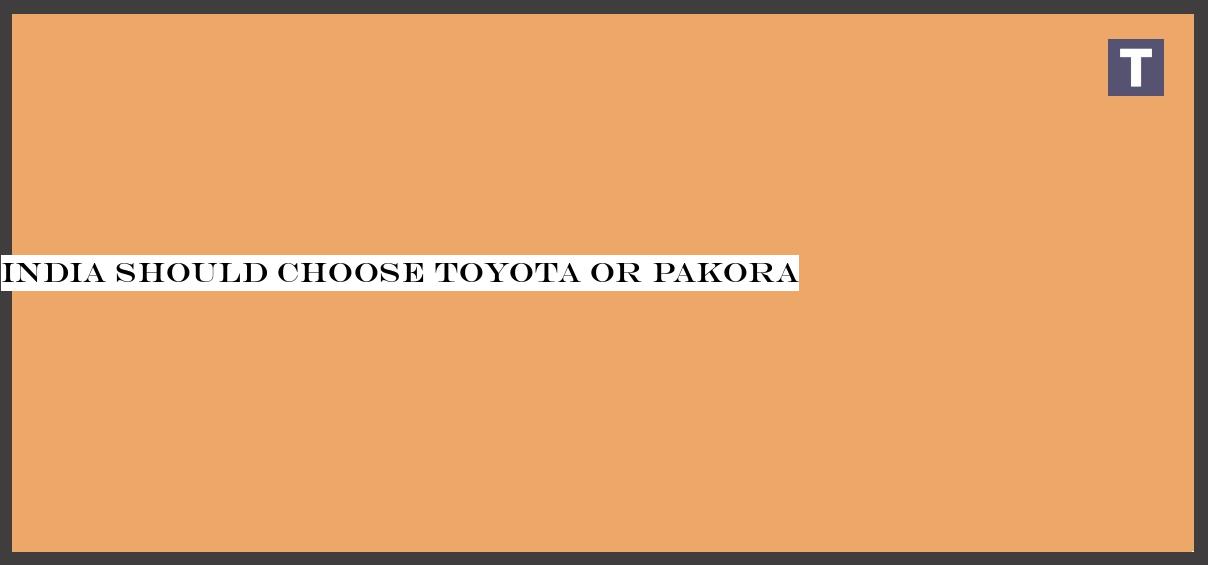INSUBCONTINENT EXCLUSIVE:
Narendra Modi says, "Make in India." Toyota Motor Corp
says, stop treating cars as though they were drugs or alcohol.The Japanese carmaker has a point about the tax structure being unviable for
the industry, and Shekar Viswanathan, vice chairman of the India unit, made it forcefully in an interview to Anurag Kotoky of Bloomberg News
However, instead of trying to address the specific concern about the high sin levies on cars, the government turned it into a public
The minister for heavy industries, who also looks after information and broadcasting, took to Twitter to announce that "the news that Toyota
will stop investing in India is incorrect."The additional luxury-tax burden - 1% to 22% depending on the size of the vehicle and engine
capacity - is what jacks up the overall levy in the world's fourth-biggest car market to as much as 50% on some sports utility
vehicles.Six years of headline management should have been enough for Prime Minister Modi's government
From justifying its bizarre overnight ban on most banknotes in 2016 to defending suspiciously cheerful gross domestic product data and
suppressing a not-so-rosy household consumption survey, Team Modi has left no stone unturned when it comes to spinning a narrative in which
it's doing everything right
The longer this pretense continues, the higher the risk of India getting stuck in a post-pandemic sub-5% growth rut.It's time to start an
honest dialogue with unhappy stakeholders - labor, capital, and subnational governments
Lockdowns are easing even though the coronavirus continues to spread
Workers desperately want jobs to return because there isn't much of a safety net beyond the family or village
Businesses weren't investing even before Covid
It's impossible to cut consumption taxes to stoke demand
India's fund-starved 29 state governments badly need the sin levies that are earmarked for their exclusive use
Businesses were hoping that these, which are in addition to the regular goods and services tax, would expire as planned in 2022
However, because of the hit to collections this year, they may continue well into the future.That isn't the whole story
Import duties on steel and electronic components may go up, ostensibly to promote PM Modi's Make in India campaign, pushing prices for
The market will then be even smaller
So what can be done?Auto analyst Govind Chellappa has practical suggestions
Even if taxes remain high for now, end the constant tinkering with the rates, regulation and the fuel policy - diesel, petrol or hybrid -
and commit to stability for 15 years
"It takes 24 to 36 months to develop a new product and another 12 months to set up the physical infrastructure
If taxes and regulation change every 24 months, how does one decide what to invest in?" Chellappa asks
Similarly, the badly designed goods and services levy needs a one-time overhaul, followed by long-term certainty.India must break out of
this vicious cycle in which taxes are high, consumer demand is low, investment and job creation are constrained, and wage incomes are
insufficient to boost purchasing power at the bottom of the pyramid
Taxes are hence exorbitant and have to be collected from a small consuming class that can afford a $23,000 Toyota sedan - and fill it up
with highly taxed gasoline that costs three-quarters more than what Americans pay.Modi said in an early 2018 television interview that those
earning $3 a day by selling "pakoras" - Indian fritters - should also be counted as employed
That would leave the government off the hook for the absence of new jobs in the formal economy
This false pakora/Toyota equivalence must end
India should enable large companies to grow and create good jobs with social security
When they're more productive and paid a little better, low-wage workers will be able to afford Made in India shirts and trousers, which, as
economist Rathin Roy has noted, are more expensive than imported clothing from Bangladesh and Vietnam.Ultimately, the Modi government needs
to focus on one simple statistic highlighted by Ambit Capital Pvt
and Singapore-based investor Akash Prakash
As much as 40% of the country's listed nonfinancial firms have revenue of less than $15 million
They're tiny even by emerging-market standards, and the ratio hasn't increased at all over the past decade.Just when India should be
presenting itself as an alternative to China by making it easy for enterprises to scale up, the Soviet-style statism that New Delhi
discarded three decades ago is creeping back into politics, policies, andeven court orders
The first step for course correction will be to listen to criticism, rather than dismiss concerns as sour grapes or fake news
will consist of a handful of very large business islands surrounded by tiny atolls that will be first to go underwater in bad weather.(Andy
Mukherjee is a Bloomberg Opinion columnist covering industrial companies and financial services
He previously was a columnist for Reuters Breakingviews
He has also worked for the Straits Times, ET NOW and Bloomberg News.)Disclaimer: The opinions expressed within this article are the personal
The facts and opinions appearing in the article do not reflect the views of TheIndianSubcontinent and TheIndianSubcontinent does not assume
any responsibility or liability for the same.(Except for the headline, this story has not been edited by TheIndianSubcontinent staff and is
published from a syndicated feed.)

